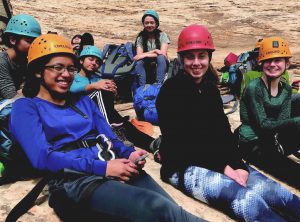
by Dr. Terry Macaluso, Head of School

EPS students transition between classes.
DURING THE SPRING TERM OF THE LAST academic year, I was disturbed with the amount of conversation I was hearing about student anxiety and depression. So disturbed, I immediately changed the content and purpose of a Program Development Day (PDD) in April, that had been well planned weeks before.
The new PDD agenda had a single topic—emotional support for our children and adolescents. How can we best support our students? In the fall of 2018, we had nearly 460 students, and we brought on a second full-time counselor. Throughout the academic year both counselors were very busy—and then some.
A couple of years ago Paul Hagen was named Dean of Students. His portfolio included activities, clubs, experiential education, and discipline. By the time we had finished the April PDD, a new structure began to emerge. We changed Paul’s title to Director of Student Well-Being. The Experiential Education program is now managed by David Kelly-Hedrick as a portion of his work. The Equity, Inclusion, and Compassionate Leadership Coordinator, Bess McKinney, will add her work to the office of Student Well-Being since so much of her work is to educate and to support all of us, but with an eye toward students from underrepresented groups. Beginning in 2019-2020, EPS will also have a full-time nurse, Stephanie Hinson, who has worked as a neonatal and emergency room nurse—in addition to which she is mother to four EPS students, one of whom is an alumnus.
“We are responsible for leading [children] toward independence; they have to know that they’re capable and that they can manage the situations life presents.”
How does outdoor education fit into student well-being? Research tells us that students need support for mental and physical health, and that understanding differences among people contributes to mental health, as does time in nature. Whether a weekend outing or a trip to the Galapagos, young adults need exposure to the natural world—and they are getting less and less of that as our time and attention turns, increasingly, to screens.
So, we’ve built the team, begun to coordinate the effort to do more programming to provide tools aiming to enable students to cope; we are doing more than ever to build resilience in our students. Resilience comes from learning, throughout one’s life, how to manage ambiguity, how to cope with uncomfortable situations, and why it is crucial to develop a personal sense of self to generate the will required to be a functional person in the world. Essentially, that is the work of all of education—formal or not—for people between the ages of five and twenty-five.

Eastside Prep students on the Canyonlands EBC Week trip.
In addition to formalizing our effort, and adding human resources so necessary for this work to be efficacious, we are working to understand more about why students feel the pressure—the kind of pressure that weighs on them, which can lead to depression and anxiety, sometimes so extreme that thoughts of self-harm develop.
Adults—teachers and parents—have such desire to support student success that we inadvertently contribute to the stress that students feel. Sometimes the feeling of responsibility a student has to get the ‘A,’ or to open an acceptance letter from a brand-name school, is related directly to either actual or perceived messages students receive telling them what targets they have to hit to be “good.” If you wonder whether a child you teach or parent is pressuring him/her/themself because of expectations you’ve expressed either overtly or tacitly, ask them.
There’s another factor that we’re working hard to counter: students contribute to each other’s stress. Somehow, whether through social media or some other combination of existential facts, being stressed has become a badge of honor. That is something we cannot allow to become more contagious than it already is. The more students share their emotional worries with other students, the more they incite one another to greater levels of anxiety. This is why the critical issue for schools is to learn how to enable students to become more resilient. In order for the school to have a reasonable chance of being successful in this venture, we must partner with parents.
There’s another factor that we’re working hard to counter: students contribute to each other’s stress. Somehow, whether through social media or some other combination of existential facts, being stressed has become a badge of honor.
What we need from parents is a commitment to follow these two pieces of advice:
- Ask your child to be specific about what is causing stress and guide the child toward a problem-solving posture. Talk to a teacher. Talk to a counselor. Take time to get the child to express exactly what the “it” is to enable them to learn to redirect anxiety to an articulation of the problem to be solved. The causes of anxiety are not mysterious, but if adolescents aren’t pushed to identify exactly what they’re worried about, the worry becomes the focus and any chance to solve a problem is undermined.
- Do not identify a college or a “kind of college” admission to which is an expectation. College admissions is not a science. There is no right way to prepare for college. There is only becoming who one is—and that person is applying to college to find the right fit. College is not a contest; it’s another four years of formal education. We must refuse to accept the condition plaguing our young people as “normal.” It isn’t. It isn’t just social media or hormones. It isn’t too much homework or addiction to screens. It’s us.
Adults have to raise children. That means that we are responsible for leading them toward independence; they have to know that they’re capable and that they can manage the situations life presents. Now—in school—is the time for adolescents to learn to be resilient. If we adults can get out of the way and let them develop their own problem-solving strategies, and if we can help them have confidence in their capacity to be responsible for themselves, I believe we will see a decline in the insidious epidemic that threatens the social and psychological health of the next generations of decision-makers, leaders, citizens.

